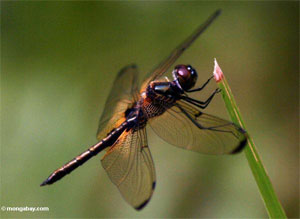Higher oxygen levels could produce monster insects
Higher oxygen levels could produce monster insects
mongabay.com
October 10, 2006
Higher concentrations of oxygen could produce giant insects according to a paper presented at the Comparative Physiology conference currently meeting in Virginia Beach, Virginia.

|
|
The paper, “No giants today: tracheal oxygen supply to the legs limits beetle size,” based on research by a team of American researchers, offers evidence that Paleozoic insects were substantially larger because they had a richer oxygen supply. During the late Paleozoic period, about 300 million years ago, the air’s oxygen content was around 35 percent, compared to 21 percent today. As a result some dragonflies had two-and-a-half-foot wing spans, while giant spiders roamed the ancient forests.
“Insects don’t breathe like we do and don’t use blood to transport oxygen,” explained a news release from the American Physiological Society. “They take in oxygen and expel carbon dioxide through holes in their bodies called spiracles. These holes connect to branching and interconnecting tubes, called tracheae… Whereas humans have one trachea, insects have a whole tracheal system that transports oxygen to all areas of their bodies and removes carbon dioxide. As the insect grows, tracheal tubes get longer to reach central tissue, and get wider or more numerous to meet the additional oxygen demands of a larger body.”
Though insects of the Paleozoic era had the same body architecture as comteporary insects, said lead author Alexander Kaiser of Midwestern University, higher oxygen concentrations meant that ancient insect needed smaller quantities of air to meet their oxygen demands.
The following scientists were involved in the research: Alexander Kaiser and Michael C. Quinlan of Midwestern University, Glendale, Arizona; J. Jake Socha and Wah-Keat Lee, Argonne National Laboratory, Argonne, IL; and Jaco Klok and Jon F. Harrison, Arizona State University, Tempe, AZ.
This article is based on a news release from the American Physiological Society.







